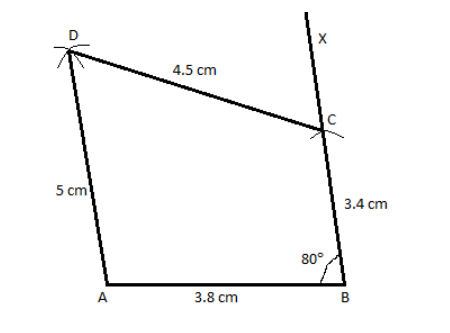
Construct a quadrilateral ABCD in which the sides; AB = 3.8 cm, BC = 3.4 cm, CD = 4.5 cm, AD = 5 cm and the angle ∠B = 80°.
Answer
578.7k+ views
Hint: In order to construct a quadrilateral with the given requirements of lengths of sides and an angle, we make a construction using the appropriate geometrical equipment. We make use of a ruler to measure the length of sides and a protractor to measure and draw an angle.
Complete step-by-step answer:
Given Data:
AB = 3.8 cm
BC = 3.4 cm
CD = 4.5 cm
AD = 5 cm
∠B = 80°
The steps of construction to construct the quadrilateral ABCD are as follows:
First we draw a line segment of length 3.8 cm and name it ‘AB’.
Then with the point B as center we make a mark at 80° with respect to the horizontal AB and draw a line BX passing through the mark we made.
Now from point B we measure a length of 3.4 cm along the line segment BX and mark the point as C.
Now with A as the center and a radius of 5 cm we draw an arc.
Now with C as the center and radius equal to 4.5 cm, we draw another arc, cutting the previous arc and we name this point as D.
Now we join the line segments AD and CD respectively.
Thus the quadrilateral ABCD is obtained.
The figure obtained after we finish construction is as follows:

Note: In order to solve this type of problems the key is to know how to construct a geometrical figure with a set of given requirements, using the help of geometrical apparatus. We measure a length of straight lines using a ruler, we measure angles using a protractor and we draw arcs or construct a circle using a compass. We find all these instruments in a geometrical box and each instrument has a specific use case. We do the construction in a stepwise manner.
Complete step-by-step answer:
Given Data:
AB = 3.8 cm
BC = 3.4 cm
CD = 4.5 cm
AD = 5 cm
∠B = 80°
The steps of construction to construct the quadrilateral ABCD are as follows:
First we draw a line segment of length 3.8 cm and name it ‘AB’.
Then with the point B as center we make a mark at 80° with respect to the horizontal AB and draw a line BX passing through the mark we made.
Now from point B we measure a length of 3.4 cm along the line segment BX and mark the point as C.
Now with A as the center and a radius of 5 cm we draw an arc.
Now with C as the center and radius equal to 4.5 cm, we draw another arc, cutting the previous arc and we name this point as D.
Now we join the line segments AD and CD respectively.
Thus the quadrilateral ABCD is obtained.
The figure obtained after we finish construction is as follows:

Note: In order to solve this type of problems the key is to know how to construct a geometrical figure with a set of given requirements, using the help of geometrical apparatus. We measure a length of straight lines using a ruler, we measure angles using a protractor and we draw arcs or construct a circle using a compass. We find all these instruments in a geometrical box and each instrument has a specific use case. We do the construction in a stepwise manner.
Recently Updated Pages
Master Class 8 Social Science: Engaging Questions & Answers for Success

Master Class 8 Maths: Engaging Questions & Answers for Success

Master Class 8 Science: Engaging Questions & Answers for Success

Class 8 Question and Answer - Your Ultimate Solutions Guide

Master Class 8 English: Engaging Questions & Answers for Success

Master Class 5 Maths: Engaging Questions & Answers for Success

Trending doubts
What is BLO What is the full form of BLO class 8 social science CBSE

Which one of the following groups comprises states class 8 social science CBSE

Citizens of India can vote at the age of A 18 years class 8 social science CBSE

Full form of STD, ISD and PCO

A couple went for a picnic They have 5 sons and each class 8 maths CBSE

Right to vote is a AFundamental Right BFundamental class 8 social science CBSE





